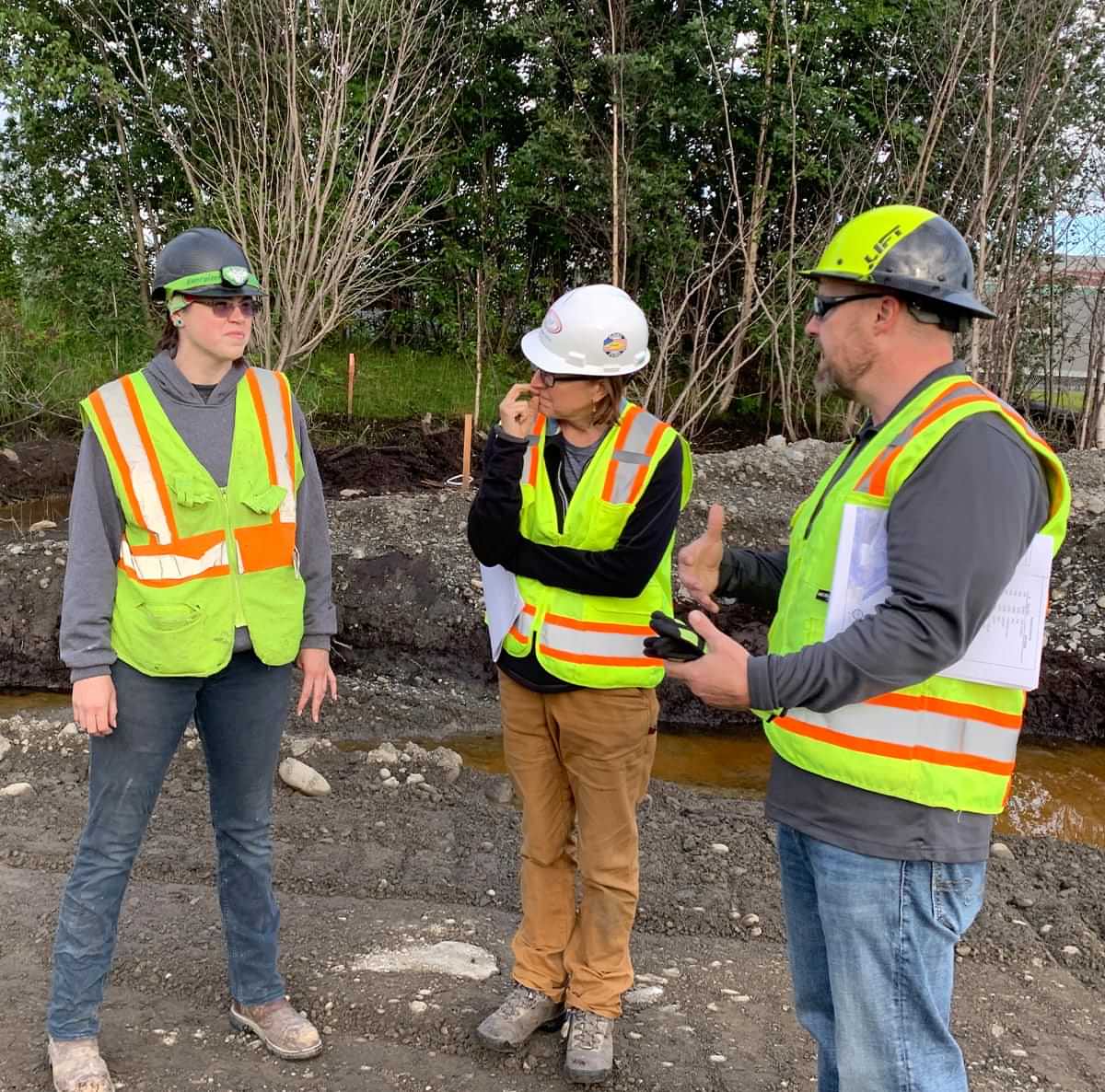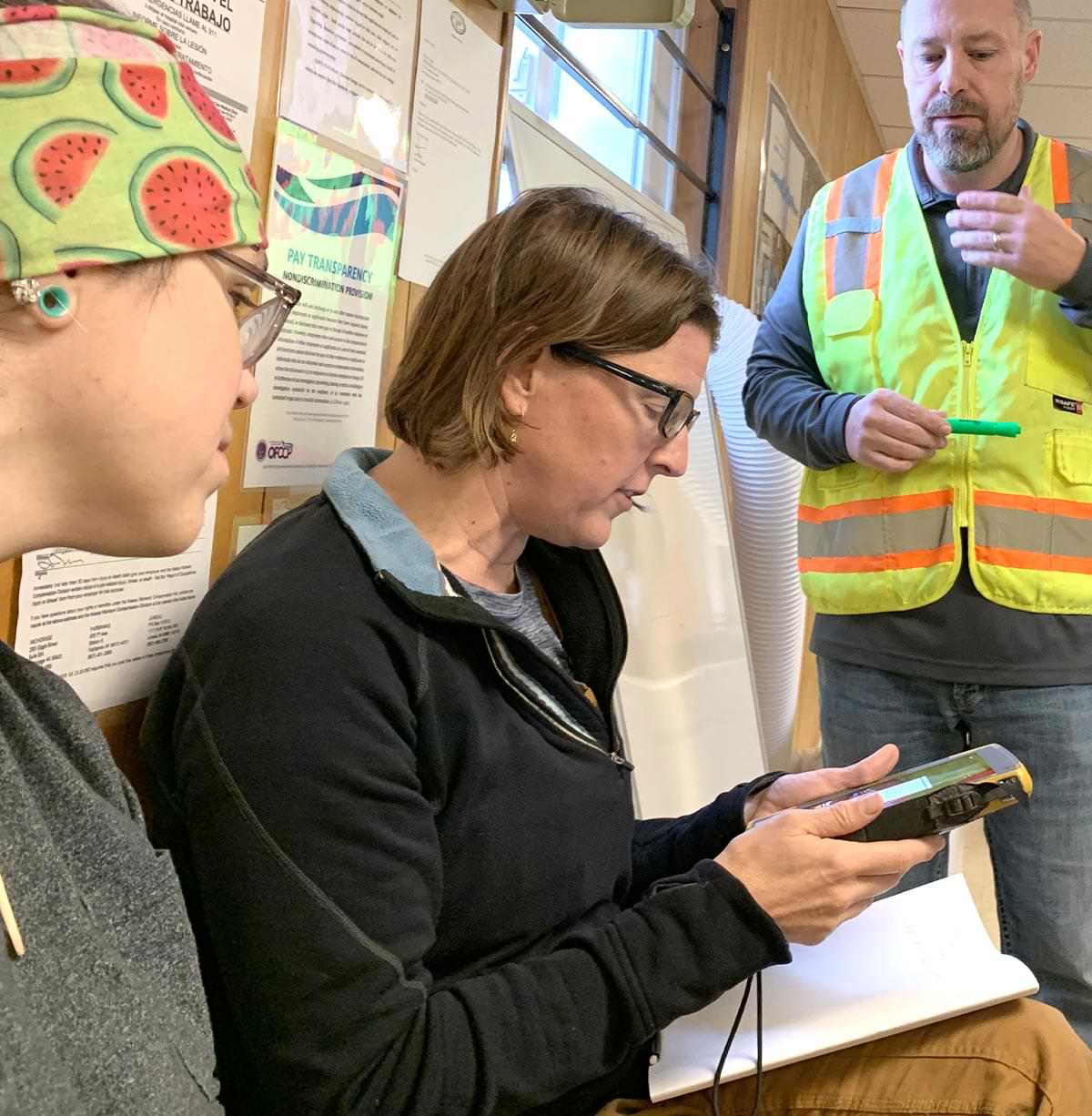
Teachers
in the Field
Educator Externship gives teachers jobsite knowledge to carry back to students
By Kevin Klott
Anchorage School District math teachers Molly Suoja and Jenne Denton learn how grading works from a QAP worker during Associated General Contractors of Alaska’s educator externship.

uality training and workforce plays such a vital role toward fueling Alaska’s economic health that AGC of Alaska is working to bridge the gap between educators and the construction community. Known as the Educator Externship, the program’s primary objective is to expose Alaskan educators to the many career opportunities available within the construction industry.
WeBuildAlaska’s inaugural educator externship took place in October. QAP served as the first hosting contractor with two Anchorage School District, or ASD, Career Technical Education, or CTE, educators and one CTE administrator in attendance.
“Starting at 7 a.m., we began by participating in the morning safety meeting and then spent the rest of the day shadowing the host contractor and exploring the varying components, roles, and workforce needs on the jobsite,” says Ruby Oatman, development director for AGC’s training and workforce.
The program’s specific focus for this externship was providing real-life applications of construction geometry concepts, such as volume, quantity calculations, risk analysis, GPS technology, and the role of a construction grade checker.
For Jenne Denton and Molly Suoja—two ASD educators preparing to co-teach the Geometry In Construction, or GIC, course at Service High—this experiential learning was invaluable.
“I heard there was the potential of a job shadow, and when it finally came to fruition, I jumped on it,” says Denton.
As a vertical commercial carpenter, Denton’s background provided a unique perspective. Her experience in the construction industry, combined with her role as a construction trades educator, allowed her to approach the externship with a rich understanding of the field.
“I found the information very intriguing,” says Denton. “I had no idea how much math was involved in horizontal construction. I knew there was math, just not the amount.”

Anchorage School District Career and Technical Education, or CTE, teachers Molly Suoja and Jenne Denton and QAP area manager Kris Jensen stand at a job site during Associated General Contractors of Alaska’s Educator Externship.

QAP area manager Kris Jensen shows Service High School CTE math teachers Molly Suoja and Jenne Denton how technology is used in construction.
“In GIC, we work on a unit involving volume, and what we learned on the QAP experience will be filtered for student use,’ says Denton.
The valuable lessons and takeaways from the externship program were not just confined to theoretical knowledge; they extended to hands-on, practical applications that directly benefit Service High students. Denton and Suoja worked closely with Oatman, as well as ASD CTE coordinator Keith Hodson and QAP’s Kris Jensen, to build a hands-on math lesson involving volume and how it will be useful as a horizontal construction worker.
This collaboration, says Denton, is a testament to the commitment to enhancing students’ education by bringing real-world applications into the classroom.
“For example, the use of an excavator loading raw material into a dump truck and how the type of soil affects the volume,” says Denton.
Real-World Experience
“The AGC Education, Training, and Workforce Development Committee played a crucial role in developing and executing the program,” says Oatman. “Committee members actively participated in hosting the externships and contributed to the program’s overall design and implementation.”

Anchorage School District CTE teacher Jason Read works with Kendall Wilson of Cadence General Contractors during Associated General Contractors of Alaska’s Educator Externship at the new Moose’s Tooth location in South Anchorage.
Jensen, an area manager for QAP in Anchorage, is an active member of the Education, Training, and Workforce Development Committee, or ETWD, which is the driving force behind the Educator Externship.
Jensen’s passion for teaching and the desire to expose the next generation to the world of construction led to playing a vital role in the program.
“We have a workforce that is excited to tell people about what we do and our journey to get there,” says Jensen.
Jensen’s role as the contractor host was to provide a safe and educational experience for the educators, allowing them to witness construction work up close and fostering direct conversations with construction employees. These dialogues served as a platform for construction professionals to share their experiences, describe their roles, and outline their career journeys.
“One of the key takeaways was how much we use general mathematics and geometry in construction,” says Jensen. “Also, that all genders, race, and age have opportunities and work together to meet common safety and production goals.”
In a bid to get educators excited about the construction industry, Jensen introduced them to cutting-edge technologies.
“We also introduced educators about the cool technologies like GPS and drones that we now use in our industry, along with big equipment,” says Jensen.
Denton and Suoja experienced firsthand the intricacies of construction projects. They observed a mass excavation operation on one site and fine-grading layout for pedestrian ramps that meet ADA requirements on another site. They learned how mathematical equations were employed to determine material quantities and the number of trucks required.
“It was a comprehensive lesson in planning, executing, and managing resources,” says Jensen. “We have to be able to spread the word about the opportunities in our industry to the next generation of workers. It is critical to get in front of educators and students and expose them to the many rewarding opportunities our industry provides.”
Education and Industry
“Externships should be a part of any educational initiative,” says Hodson. “When teachers are connected to local businesses and aware of how the infrastructure around them works, they are more likely to point students in the right direction.”
Hodson emphasized the significance of teachers with real-world experience outside of the classroom: “If a teacher has only worked in education their whole career, how can they talk to students about work on the slope or welding unions? They can’t.”
“When teachers are connected to local businesses… they are more likely to point students in the right direction.”
-Keith Hodson, ASD CTE Coordinator
“If there is interest and time, we match teachers up with business partners,” says Hodson.
Collaborations with industry leaders, like the AGC of Alaska, are instrumental in promoting education and industry synergy, says Hodson. The impact of future Educator Externship experiences on CTE programs will be significant.
“Because of their new knowledge, when teachers are having side conversations with students, they will be able to recommend opportunities,” says Hodson.
Oatman also emphasized how the program exemplifies the power of collaboration between education and industry, saying, “It serves as a conduit for educators to gain firsthand experience and knowledge of the construction field, creating a pathway for informed and inspired teaching that will, in turn, shape the future workforce of Alaska.”
BC Excavating and Big State Mechanical have both signed up to host educator externships with the goal of exposing more educators to the industry. If you are a contractor or educator interested in participating, please reach out to Oatman at ruby@agcak.org.